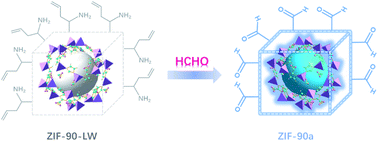The selective and sensitive detection of formaldehyde by ZIF-90-LWvia aza-Cope rearrangement†
Abstract
Formaldehyde (FA), as one of the simplest reactive carbonyl species (RCS), is widely known as an environmental toxin and carcinogen. In this work, a new ZIF-90 type material (ZIF-90-LW) was synthesized and investigated, which combines the two strategies of “2-aza-Cope rearrangement” and “MOF structure”, by the combination of a pre-functionalized 2-allylaminoimidazole ligand and Zn2+ salt under solvothermal conditions. From this, the hurdle of selectivity over other carbonyl compounds (RCS) could be overcome despite their similar electrophilic reactivities to FA, and a prominent fluorescence turn-on type signal was realized through the 2-aza-Cope rearrangement mechanism. A good linear relationship (R2 = 0.9979) was obtained by fitting the fluorescence intensity towards FA from 0 to 25 mM, and the detection limit of ZIF-90-LW for FA was 2.3 μM. In addition, it also showed potentially useful sensing ability for the detection of FA in the gas phase, and might therefore be used to rapidly detect FA with a response time of 28 s in the liquid phase. All of the above features clearly demonstrate that ZIF-90-LW has great potential for sensitive and selective recognition of FA in the environment.



 Please wait while we load your content...
Please wait while we load your content...